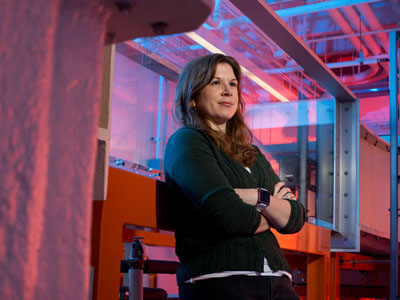Assistant Professor Melissa A. Green
How long have you been at SU?
Since January 2012

What school/college/department do you work in?
College: Engineering and Computer Science; Department: Mechanical and Aerospace Engineering
Briefly describe your area of research:
I study unsteady fluid dynamics. This involves both water channel experiments, and some fairly involved numerical analysis of the data obtained either from those experiments, or from simulations we generate either in-house or from collaborators.
We do a Lagrangian analysis, which means that even after we’ve solved for the time-varying velocity field everywhere in time, we observe the behavior of particle trajectories through the fluid to study the mass transport in space and time. This is something you can simulate in post-processing using the simulation data.
Describe which SU’s Research Computing technologies and resources you currently use:
In my group, we use both the Campus Grid and we have a machine hosted in the AVHE.
How do these resources contribute to the advance of research on the SU campus?
With the help of the ITS staff who manage the Campus Grid, we have been able to accomplish some things that I was not anticipating when I started my position here.
I have some moderately-sized 3D turbulence simulation data on which I have done some 2D analysis runs in the past. Because my algorithms are essentially infinitely parallelizable, my students have been able to generate a database of analysis throughout the entire simulation domain for all time snapshots we had collected. In terms of doing statistics on the analysis, this is a big advantage that I have not had before.
Office of Naval Research funds 3-year LCS Project
Learn More: Web site
Melissa A. Green, assistant professor in the Syracuse University College of Engineering and Computer Science, was a recipient of a three-year grant from the Office of Naval Research (ONR) for her work on “Lagrangian methods in unsteady propulsion: characterizing vortex wake structure and force production.” This funding comes from ONR’s Biologically Inspired Underwater Propulsion Program, and Green and her research group will receive over $650,000 during the three year period.
Green specializes in the area of fundamental Fluid Dynamics, specifically vortex dynamics and bio-inspired propulsion. As part of this grant, she will use novel analysis techniques to detect the formation and evolution of vortices that are generated when fin-like surfaces are oscillated in water. In the case of aquatic locomotion, this flapping produces forward thrust while simultaneously creating a chain of vortices in its wake. Green will use the ONR funding to develop experiments that incorporate new equipment to measure force directly on the flapping surfaces, as well as to synchronize those measurements with visualizations of the vortex wake. Her research will inform efficient design and control strategies for a range of underwater vehicle applications.
